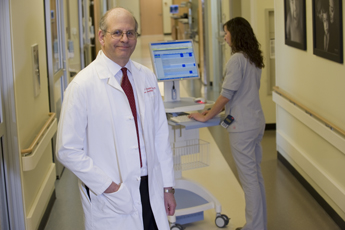It’s the largest construction project ever undertaken at the VCU Medical Center. The new Critical Care Hospital has 15 floors, each nearly half the size of a football field. But it’s the little things that catch my attention.

Behind Dean Jerry Strauss, a nurse enters patient information at a “COW”–short-hand lingo for a Computer On Wheels. Because of the Critical Care Hospital’s unparalleled wireless network, physicians and nurses can access and enter patient information on the fly. At the patient’s bedside or pushed down a hallway, there is no spot in the facility where the signal is weak or in danger of losing connectivity. It’s the key to making Electronic Medical Records function as they should.
Those details tell the story of the thought and planning that went into our state’s only hospital devoted solely to critical care.
I notice the lack of noise in the Newborn ICU. Families are welcome in the rooms of even the sickest patients in the Burn Center. And COWs are free to roam down hallways and around corners.
Let me tell you more about that last item.
“COWs” is short-hand lingo for Computers On Wheels. They are the key to making Electronic Medical Records function as they should, because they make it possible for physicians and nurses to access and enter information right at the patient’s bedside. Not down the hall at the nurses’ station where, too often in the past, you had to wait in line to get access to a computer.
And because the facility has an unparalleled wireless network, you can wheel those COWs anywhere you need them to go. There is no spot where the signal is weak and threatening to lose connectivity. That wireless quality supports other communications as well: telemetry, cell phones, two-way radios and paging systems.
When you tie it all in together, you get real power. A patient’s bedside monitor feeds critical messages on fluctuating vital signs directly to wireless phones that our nurses carry at their waists. Each unit’s sheer size means that nurses do not always have a direct line of sight to all patient rooms—so this kind of reliable, two-way contact was essential.
And what makes the NICU so quiet? Rubber floor tiles, an acoustical ceiling and privacy curtains on plastic tracks and rollers. Based on years of research into the needs of premature and critically ill newborns, these are important ingredients for the development of each tiny patient. As is the size of their private rooms—yes, even these smallest patients get their own space to encourage the family’s involvement from the very beginning.
That family engagement is important in the Evans-Haynes Burn Center, too. Our nation’s first civilian burn unit made a name for itself by pioneering advances in burn care, but its space constraints meant that sometimes family had to be asked to leave the unit. In fact, even patients sometimes had to leave when their wounds required a trip to an operating room. Now, the center has a large procedure room down the hall equipped with high-intensity lighting and special water purification devices that will help prevent infection in some of the most susceptible patients.
Patient safety was the overarching goal in the design and construction of the $184-million hospital. But their comfort—and their family’s—was a close second.

Jerome F. Strauss, III, M.D., Ph.D.
Dean, VCU School of Medicine
Executive Vice President for Medical Affairs, VCU Health System

